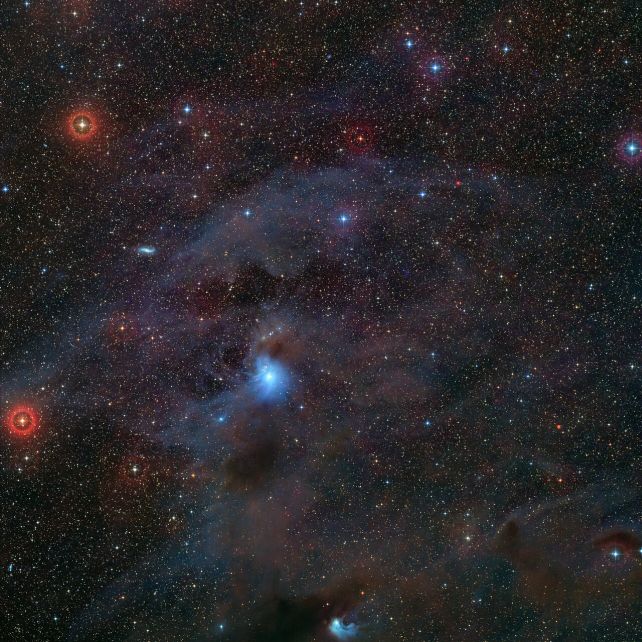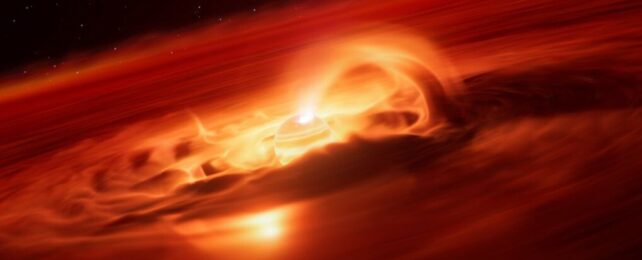A baby world just drifting through space without a star to call home has been caught in a record-smashing feeding frenzy.
Not only is this the highest growth rate ever recorded for a planetary-mass object, but Cha 1107-7626 is exhibiting behavior only ever seen before in growing stars and brown dwarfs. Yet it's just 5 to 10 times the mass of Jupiter – well below the 80-Jupiter lower mass limit for stars, and the 13-Jupiter lower mass limit for brown dwarfs.
Astronomers measured a peak accretion rate of around 10⁻⁷ Jupiter masses per year – about 6 billion metric tons per second, and the burst persisted for at least two months.
Related: Rogue Planets Floating in Space Appear to Be Forming Their Own Moons
"This is the strongest accretion episode ever recorded for a planetary-mass object," says astronomer Víctor Almendros-Abad of the National Institute for Astrophysics in Italy.
"People may think of planets as quiet and stable worlds, but with this discovery we see that planetary-mass objects freely floating in space can be exciting places."

Rogue exoplanets – officially known as free-floating planetary-mass objects, or FFPMOs – are a mystery that has only recently escalated as improved technology has revealed far more of them than we knew existed.
As the name suggests, they are objects with planet-like masses below 13 Jupiters – but unlike most of the 6,000-plus planets we know about, they don't have a star to call home.
This has sparked fascinated speculation about how these peripatetic worlds formed: Did they develop around a star and get booted out into space by gravitational interactions? Or did they just form by themselves, like a star, but without enough material around them to grow to star size?
The new observations of Cha 1107-7626, located 620 light-years away in the Chamaeleon star-forming complex, strongly suggest the latter origin for at least some of these curious objects.
Cha 1107-7626 was discovered in 2008, and caught astronomers' attention because it showed behavior consistent with accretion – growth from feeding on a disk swirling around the object.

Almendros-Abad had embarked on an observation campaign of the object in the first half of 2025, taking periodic snapshots of its behavior to study this accretion. They turned the XSHOOTER instrument on the ESO's Very Large Telescope (VLT) in April, May, and June at different times. Follow-up in July and August tracked the event across optical to mid-infrared wavelengths.
Everything looked pretty standard until late June, when Cha 1107-7626 abruptly brightened. The increase in light, the astronomers were astonished to discover, resembled nothing so much as an EXor burst – a brightness increase seen in a young star, typically associated with an episode of accelerated accretion. Crucially, its spectrum showed hydrogen features that are the hallmark of magnetically funneled accretion seen in stellar EXor bursts.
A careful analysis ensued, along with an examination of archival data. The researchers found that not only had Cha 1107-7626's accretion increased to six to eight times its typical rate, but it had also done so at least once before, back in 2016, suggesting that these outbursts may be recurring. It was still ongoing when observations ended in August.
Observations with VLT and JWST have shown other ways in which Cha 1107-7626 behaves like a star. It appears to be surrounded by an extensive disk of material containing silicates and hydrocarbons, similar to the disks seen around baby stars.
During the flare-up, the object became three to six times brighter in visible light, remained nearly unchanged in the near-infrared, and showed a small increase in brightness in the mid-infrared as the inner disk warmed. JWST also spotted a hint of water vapor and a slight change in carbon signals, showing the burst stirred the disk's chemistry, while the dust signature stayed the same.

This behavior suggests that Cha 1107-7626 formed alone in a cloud within the Chamaeleon complex, starting from a dense knot of material that collapsed under gravity, in a manner similar to how stars form. It's still possible that the planet formed around a star, but this is difficult to reconcile.
The accretion spectrum and disk changes better fit a direct-collapse, stellar-style origin; and while an early ejection from a star system isn't impossible, it would have to be unusually gentle to preserve such a stable, chemically active disk.
It's a marvelous result that dramatically enhances our understanding, not just of FFPMOS, but of the different ways the Universe can make the objects that fill it.
"The idea that a planetary object can behave like a star is awe-inspiring and invites us to wonder what worlds beyond our own could be like during their nascent stages," says astronomer Amelia Bayo of the ESO.
The research has been published in The Astrophysical Journal Letters.
